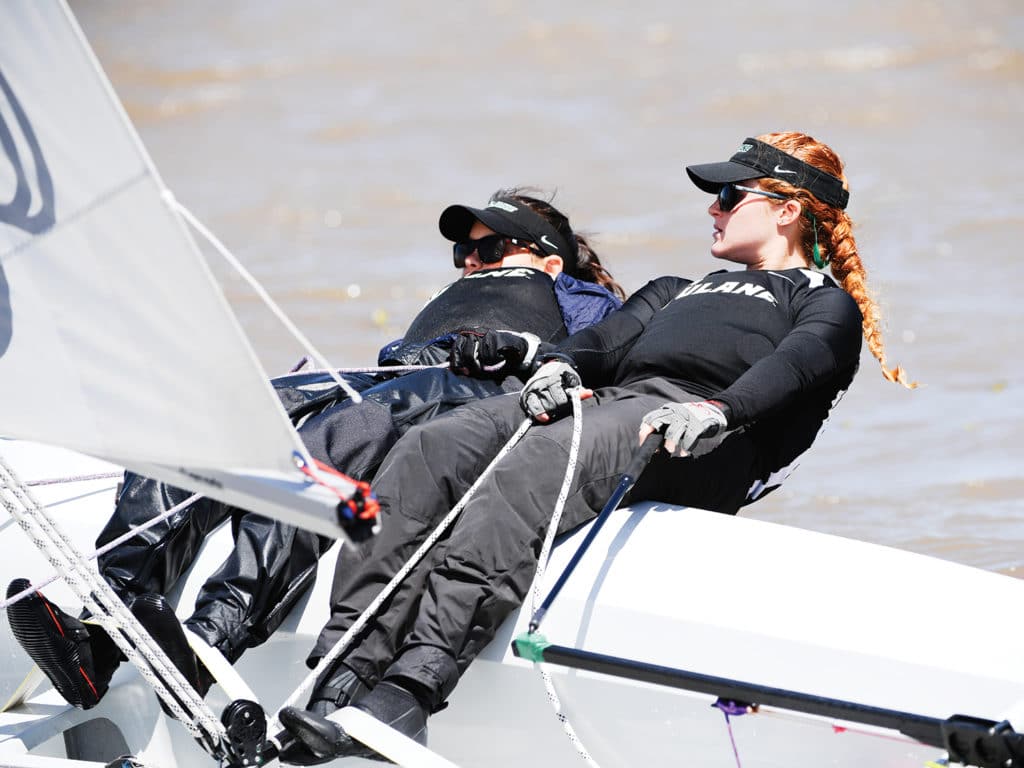
The Tulane University Sailing Team has celebrated a few firsts in the last two years: hiring Charles Higgins as its first varsity head coach in 2017 and elevating the sailing team from club to varsity status during the 2018-19 academic year. The existing club team did not petition for varsity status; instead, it was an opportunity that came to the program. These two changes meant lots of transition for the program and student athletes.
“I used that first semester before we were elevated to varsity status as a transition period for the team,” Higgins says. “This period was vital because it gave the team members time to discover whether being a varsity student athlete was going to be what they wanted. Given that only 6 percent of all college students are varsity student-athletes, it was not surprising that quite a few decided it was not for them.”
The sailing team went from a casual environment to morning workouts, set practice schedules and regatta travel—which means less free time and more work; that is not for everyone and was a transition the club sailors had to evaluate for themselves.
“A little more than half of the club team chose not to stick it out, and that is completely fine,” Higgins explains. “Those that are still with the team are incredible individuals. They didn’t ask for this, and yet they made their own decision to give it their all. They are as committed as any recruited team member, and certainly every bit as valuable to the team.”
Despite losing more than half of the initial sailors, the team has grown in the past 18 months. “College sailing pales in comparison to most sports when it comes to the extent of its recruiting, and I knew that I would have to be very active on that front if I wanted to build a nationally competitive team quickly,” Higgins says. “Navigating that process can be difficult, especially for a new varsity program. It took a lot of work, and it is an area that I spent a considerable amount of energy on. Ultimately it paid off, and I’m looking forward to this next year’s class, which will help us make a considerable jump competitively.”
The program itself is still learning how to function at the varsity level. Higgins did not have the advantage of varsity resources being passed down to him; instead he had to figure it out alongside his team members.
He says everything from how the team gets to and from practice, to travel policies, to study hall, to registration for classes, to student housing were completely new to everyone. Another big change is travel. Tulane is fairly isolated from college sailing, which means the team flies almost everywhere—but it is a better and safer mode of transportation.
One piece of advice Higgins would give to any team and school looking to transition to a varsity program would be to have a good understanding of what the big-picture and day-to-day changes are going to be. He believes a program should not try for varsity without making sure it’s a change it can maintain for years to come.
“Fortunately, the team was well-organized and run, and when the right circumstances came along, they were able to help make it happen,” he explains. “That is likely true of every team that has made the transition in the last 10 years.”
Higgins worked as an assistant coach at his alma mater, Old Dominion, for 10 seasons before joining Tulane. He looked to the East Coast to gain competitive sailing experience, having grown up in Texas. Tulane becoming a varsity program was a unique opportunity to go back to his home region and help create something. “The combination of being able to come back to this area, start a program and mold it how I wanted, and know that I had the resources and backing by the university to get it done, was a perfect storm that I couldn’t pass up,” he says. “It was a once-in-a-lifetime opportunity.”
Higgins’s education on the water as a collegiate sailor and as an assistant coach helped prepare him to take on the head coach role. “I was told a long time ago that the difference between assistant and head coaches is that assistants give advice, but head coaches make decisions,” he says. “There is no blueprint for starting a sailing program. There is still so much ahead of us. But I am embracing the process, and it’s been exciting to see how far we have come.”
Tulane is a unique place to get an education, and New Orleans is a city unlike anywhere else in the country, Higgins says: “The combination of an elite education, fun location, and the ability to compete at the highest level of our sport at the same time is an experience that is unmatched. It has been exciting and rewarding to be leading this process, and I am looking forward to what this program can achieve.”









